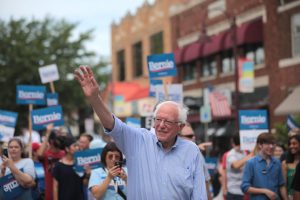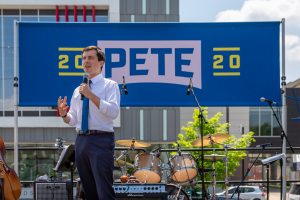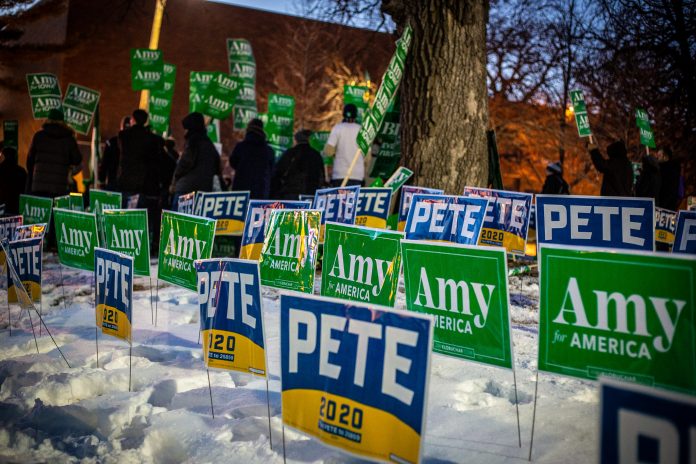Now that primary season is underway we are again reminded of just how flawed the current system is. Every four years the political class and some scholars raise questions about why we choose our presidents this way, but after the election these questions fade away as more seemingly pressing and urgent issues take over, so while we tinker with the rules changing them slightly for every nominating season, we never address the underlying problems.
Problems with the Current System
In general, criticisms of the current system fall into five different categories. First, there is concern that Iowa and New Hampshire, the two earliest states, play a much bigger role in the process than their size would suggest. This problem is deepened because these two states have few nonwhite voters. This means that not only do candidates of color have a tough time getting traction in the earlier states, but that voters of color, the backbone of the Democratic Party, do not get a meaningful say in the process until the third and fourth states, Nevada and South Carolina.
This cycle three highly qualified and intriguing Democratic candidates, Cory Booker, Julian Castro and Kamala Harris dropped out of the race before the voting even started due, in no small part, to their poor poll numbers in Iowa and New Hampshire. It is not hard to imagine how if the first primary had been in another, more diverse state, at least one of these candidates would still be in the race and viewed as having a good shot at the nomination while, for example Pete Buttigieg, whose support remains overwhelmingly white, might have dropped out.
This is not just a problem for individual candidates and non-white voters, but it has an impact on the issue of electability as well. For Democrats to win, they need to be able to mobilize large numbers of African American and Latino voters, but by culling the field before those voters have had a chance to evaluate and respond to the candidates, they make that task even more difficult.
The second criticism of the current nominating system is that it takes too long. This year, for example, there are four months between Iowa and the last primaries. The long primary season means that candidates have a lot of time to attack each other and then have a relatively short general election season. This almost always benefits the incumbent and is one of the reasons why incumbents are usually reelected.
A third concern is that superdelegates play too large a role. It is also a problem that the role that superdelegates play, and the number of superdelegates, changes each election cycle. Superdelegates are essentially party insiders and leaders who do not have to win election to the convention through the primary process. The presence of superdelegates raises a bigger picture question of what the role of party leadership, as opposed to the party’s grassroots, should have in choosing the nominee.

Bernie Sanders’s electoral base is limited to the left wing of the Democratic party. (PHOTO BY: FLICKR/GAGE SKIDMORE/CC BY-SA 2.0)
A related problem is that the rules for the nominating process change not only from cycle to cycle but from state to state. Some states have caucuses, others have primaries. In some states only registered Democrats can vote in primaries. In others anybody can vote in a Democratic primary, while in still other states different rules apply. This means that in some states people who are not Democrats can help choose the Democratic Party nominee, and also gives opportunities to Republicans to create mischief by voting for a candidate who is perceived as weak.
The last major problem is that the primary system allows a candidate who has a loyal following, but is not widely popular in the party to become the nominee. This happened to the Republicans with Donald Trump in 2016, but is a concern for some Democrats this year regarding two of the current frontrunners, Bernie Sanders, whose base is limited to the left wing of the party and Pete Buttigieg whose supporters include very few people of color. This problem is the inevitable result of multi-candidate races where voters can only express a preference for their first choice.
Current Proposed Solutions
The two solutions that we here the most are to have a different state go first. Illinois which is much more diverse than Iowa has been suggested to fill this role. This is a good idea, but it only partially solves some of the problems. Either Illinois or a similarly diverse state would be better than Iowa, but no state is perfect. Diversity in the US is about demographics, but it is also about geography, economy and region. For example, there are some issues, like police brutality, that are very important for people of color nationally, but not all people of color have the same concerns and priorities. For example, African Americans and Latinos in the Bay Area, New York or Los Angeles are generally much more concerned about issues around housing costs than African Americans and Latinos in Ohio or even Illinois. Similarly, climate change is a much more urgent feeling issue in coastal states like California or New York than in places like Illinois and Ohio. On the other hand, the opioid epidemic has hit Ohio as hard as any state, so all voters there are likely more concerned about that than voters in Iowa or New York might be. On balance, it would be better to open the primary season in Ohio or Illinois, but it would still be a primary process that is too long and with unclear rules. Therefore, this is only a solution to one aspect of a much more complex problem.
The presence of superdelegates raises a bigger picture question of what the role of party leadership, as opposed to the party’s grassroots, should have in choosing the nominee
A second solution that is occasionally raised is the idea of a national primary. This is appealing in both its simplicity-everybody gets to vote at the same time-but also because it moves the process along quickly thus avoiding the months of primaries and caucuses. However, there are many problems with this approach. First, it makes money and name recognition even more important. Candidates who start out with less name recognition, but more political skill and potential appeal to voters have little chance in this scenario. A one-day primary would make the election almost entirely about early money, thus potentially making billionaires and SuperPACs even more influential. Additionally, so long as the one-day primary awarded the nomination to whichever candidate won a plurality of the vote, it would not solve the problem of the party nominating a broadly unpopular candidate with a narrow base.
Solutions
The only way the primary system can be fixed is if the Democratic National Committee (DNC) is able to act more decisively. Currently, state parties run primaries and make decisions about how that primary will be conducted. The DNC has no real legal standing to simply take this over, but it has a lot of both carrots and sticks. The DNC can tell parties that if they don’t participate in the proposed reforms, they would get fewer delegates to the DNC convention, less preference when it comes to implementing the nuts and bolts of the reform package, not be eligible to host a debate for the candidates and the like. Similarly, state parties that support and help facilitate the reforms can be rewarded by giving politicians from that state speaking roles at the convention, more preference in the implementation of the plan and the like.
My proposed reforms fall into two different categories-the electoral system and the schedule. The key to these reforms would be that they would have to be as universal as possible to make the greatest impact. Currently, the different states employ two flawed electoral systems. Caucuses are too exclusive because they require a substantial commitment of time from citizens and are often hard to understand. However, the one big advantage they offer is that they allow some method for voters to express second or even third choices. In Iowa, for example, caucus goers whose candidates did not get fifteen percent in the first preference could then support their second choice candidate. Primaries, by contract, are much easier to figure out and allow more time for people to vote, but they only allow voters to make one choice. In multi-candidate races, this is a major problem because it doesn’t penalize polarizing candidates and leaves many voters upset that their first-choice candidate got nothing.
The way to solve this is first to limit participation to Democrats. This will help bring some discipline to candidates and to the party while eliminating meddling by Republicans or those with no party. If the DNC is not ready to take a firm position that only Democrats should choose the Democratic nominee for president, they might as well fold up the tent now. This is only a first step. The second step is for all primaries to be based on rank order voting with a fifteen percent threshold for delegates. That threshold would be statewide with delegates distributed accordingly. This would keep the system simpler, easier to understand and more democratic than the formulas used by many states now. That fifteen percent could be negotiated a little bit, but that is about the right number.

Pete Buttigieg’s electoral support remains overwhelmingly white. (PHOTO BY: FLICKR/GAGE SKIDMORE/CC BY-SA 2.0)
The way this would work is that voters could rank order as many candidates as they wanted when they voted. Those candidates who were the top choice of at least fifteen candidates would immediately be eligible for delegates. Then, the votes of the candidate with the fewest votes, would be reallocated to the second place choice of each of those voters. Any candidate who was then pushed over the fifteen percent threshold would also be eligible for delegates. This would then be continued until all votes were counted and reallocated. Candidates who got fifteen percent or more the first time would be able to increase their number as more votes were allocated.
The way this might look in 2020 is that if in a given state the first round was something like:
Sanders 23%
Buttigieg 20%
Warren 16%
Biden 14%
Klobuchar 12%
Yang 7%
Steyer 5%
Gabbard 3%
Sanders, Warren and Buttigieg would be immediately eligible for delegates. Then, Gabbard’s votes would be reallocated with, for example, two percent going to Sanders who would then be at 25% and one percent to Yang who would now be at eight percent and still not eligible. Then Steyer’s voters would be reallocated with, for example, three percent for Biden, putting him over the threshold at 16%, two percent for Klobuchar putting her at 14% and one for Buttigieg moving him to 21%. Then Yang’s now eight percent would be reallocated with, for example, three each going to Sanders and Warren and two to Klobuchar and getting her to the threshold. The final vote would then be:
Sanders 28%
Buttigieg 21%
Warren 19%
Biden 16%
Klobuchar 16%
This example is meant to be illustrative and is based on how voters might rank order their choices, but it demonstrates how the system could work and how voters would be able to express a more nuanced opinion. It also guarantees that although every voter might not get their first choice, every voter would have their voice heard and have a say in who their party nominates.
Fixing the electoral system would be helpful, but it does not solve problems of scheduling that place too much emphasis on heavily white electorates or that drag the primary season out too long. The second reform would fix that. Rather than have a national primary, the primary season would be broken into four super primary days each two weeks apart. These would occur, for example on February 1st, 15th, 29th and March 14th, but could begin later. The convention would also be moved up to 4-6 weeks after the last primary. These super primaries would be regional as the states would be divided into four regions: East, South, West and Middle. Each region would be roughly equal in size, although the South would probably inevitably be bigger than the rest. Democrats abroad and other areas could be distributed among the four regions. The District of Columbia and Puerto Rico would vote with the east.
African Americans and Latinos in the Bay Area, New York or Los Angeles are generally much more concerned about issues around housing costs than African Americans and Latinos in Ohio or even Illinois
The order in which these regions voted would be unimportant because they are all big enough to matter. With each region sending 20 to 30 percent of the delegates to the national convention, they would all have an equal, but different, role in the nominating process. Moreover, they are all racially and ethnically diverse in different ways and all contain a broad range of agriculture, industrial, information, service and other sectors of the economy. Breaking this up by geography would make it easier to campaign as candidates would have to cover less distance when focusing on one region, although trips to Hawaii and Alaska would be time consuming for the western primary. It would also keep multi-state media markets, like the tri-state area around New York City, in the same region and voting on the same day, making campaigning more cost effective in an albeit relatively minor respect.
The condensed primary system would still make it critical to raise early money, but two weeks between regional primaries would be enough for candidates to raise money and financially reload for the next round. However, candidates who got drubbed in one of the earlier regions would likely have trouble raising enough money to continue. This would give an advantage to national candidates and force all candidates to campaign nationwide. Combined with the rank order system of voting this would create two structures that would push the party to nominating a broadly acceptable and competitive candidate, which is exactly what a nominating process should do-and is not able to do now.
These proposals seem fanciful and very unlikely given the relatively decentralized nature of both major parties with key decisions being made on the state level, but it is possible. It would require real leadership from the DNC, an effort to educate both party insiders and the public more generally about the wisdom of the new system and a willingness to perhaps offend party leaders and activists in a few small states. Given the state of American democratic and the lasting damage a second Trump term would have, it may be too late for these kinds of proposed reforms, but if we make it to 2024, the Democratic Party would be wise to move in this direction.
www.lincolnmitchell.com
Follow me on Twitter at http://twitter.com/LincolnMitchell

